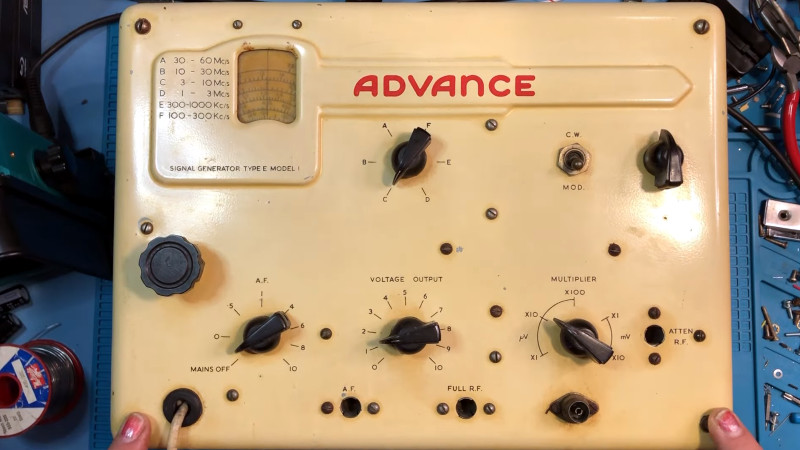At Hackaday, we comb the world of tech in search of good things to bring you. Today’s search brought up something very familiar, [Jazzy Jane] has an Advance E1 tube signal generator, the same model as the unit on the shelf above where this is being written. It’s new to her, so she’s giving it a teardown and fixing any safety issues before powering it on.
For a 70+ year old unit, the quality of these instruments was such that they remain useful and reliable to this day. Unsurprisingly a few things need looking at, such as an aged mains lead and a pair of filter caps in the power supply which haven’t aged well. These parts failed on the E1 here too, and while she’s taking the time to order appropriate replacements we have to admit to being cheapskates and robbing parts with an appropriate working voltage for ours from a nearby PC power supply.
Where this one becomes rather interesting is in an extra switch and socket. It’s a wafer switch with a load of capacitors, and the best guess is it provides some adjustability for the inbuilt audio oscillator which had a fixed frequency on stock models. This is part one of a series though, so we’re looking forward to finding out its purpose in the next installment. Take a look at the video below the break, and if that’s not enough, we seem to have had more than one piece of vintage British test equipment here of late.















As I am Dutch, of course I have a few of the Dutch equivalent of this one, made by Philips, the GM2308. In one sweep from 0 to 16 Khz and back. It uses two hf oscillators and a mixer to get the difference, followed by a lf filter, adjustable power amp and a cat’s eye to adjust it for zero Hz. I am using them for my electronic music, together with a 1958 Echolette tape echo.
https://m.soundcloud.com/soundjunkie-nl/2308_2308_lette
https://www.radiomuseum.org/r/philips_schwebungssummer_gm230801.html
As a fellow Dutch man, same here. The old Philips line of instruments are very nicely build and a beauty yo see with the black on stainless (?) Contrast. Still have the GM2883 (if i am correct on the number) and some other old Philips equipment. Once these where sold off for for cents on the dollar when the Dutch State Mines had an “internal auction”, to bad i (at the time my dad, i was just a young boy) wasnt an employer so we missed out on a lot of nice stuff but luck brought it that those employers where selling it off themselves in local advertisements. Our crown piece was an AVO MK4 and CT160 suitcase model, to bad that one of them had an stuck meter (common fault) and was overloaded and fried the coil. The equipment was used for some years together with my dad who was a radio repair man and got me interested in electronics. A fellow enthousiast was interested in the Avo and using it for the intended use, not just for “collecting dust”. Still a bit sorry for letting the valve testers go. The remaining equipment is waiting for my sons to get “old enough”, maybe the interest in electronics can be passed on to them, using the “old stuff from gramps” :-)
Still got one of these myself. I checked the accuracy with a frequency counter and it’s still within spec! Not bad a piece of 70 year old British built kit.
Reminds me of this old, very British, sign gen that I picked up at a UK hamfest many years ago: The Windsor. We have sentimental ties to that town outside London. https://soldersmoke.blogspot.com/2022/04/windsor-england-signal-generator-from.html
That’s pretty cool looking!
I own a couple of Cossor wobbulators and am wondering about adding extra ranges and functions to them.
I was gifted (and subsequently restored) a Boonton 80. It’s an amazing piece of boat-anchor electronics technology. Frequency is adjustable from around 2 Mhz to 400. The output level can be calibrated–something not true of a lot of cheaper signal generators of the era. Signals produced can be modulated by an internal 400 Hz oscillator, or an external source. The thing is full of vacuum tubes and draws around 100 watts.
One of its interesting technical details is the use of bolometers… tiny, glass-encapsulated, temperature-sensitive, platinum-wire, resistors, arranged as part of a bridge, to stabilize the output. According service documentation, the platinum wires are so fragile they can be burned through by a VOM applied to measure continuity.
The oscillator element is an acorn tube, mounted in a heavily silver-plated metal drum, which also houses the band coils and band-changing mechanism.
I’m willing to bet that in its day, an instrument of this quality probably cost as much as car.
FWIW… This is not me, but here is some random youtube guy demonstrating his Boonton 80.
https://www.youtube.com/watch?v=fxEr_stI6_8
“the platinum wires are so fragile they can be burned through by a VOM applied to measure continuity.”
I was told something similar about the O2 sensors on automobile exhaust systems.